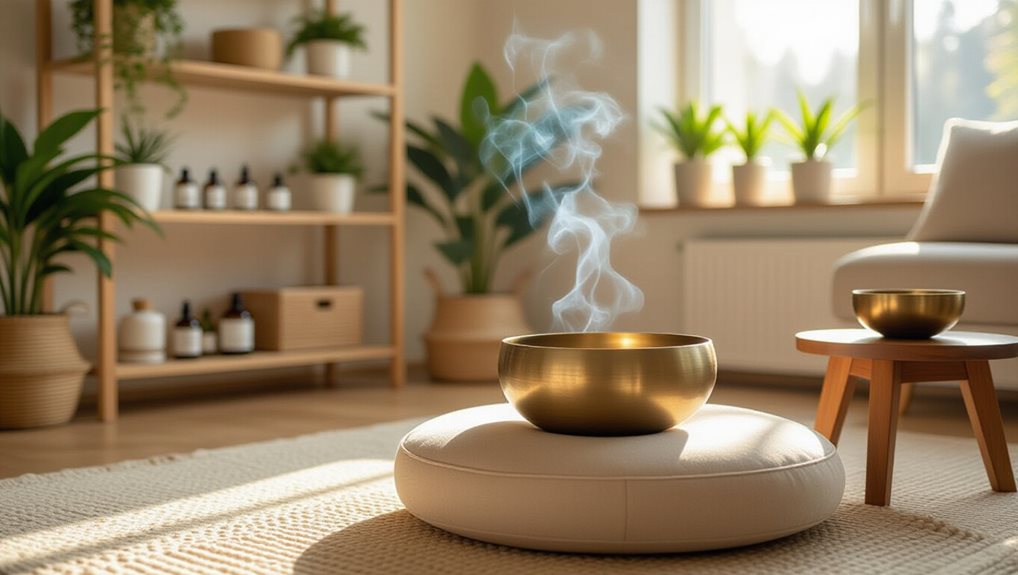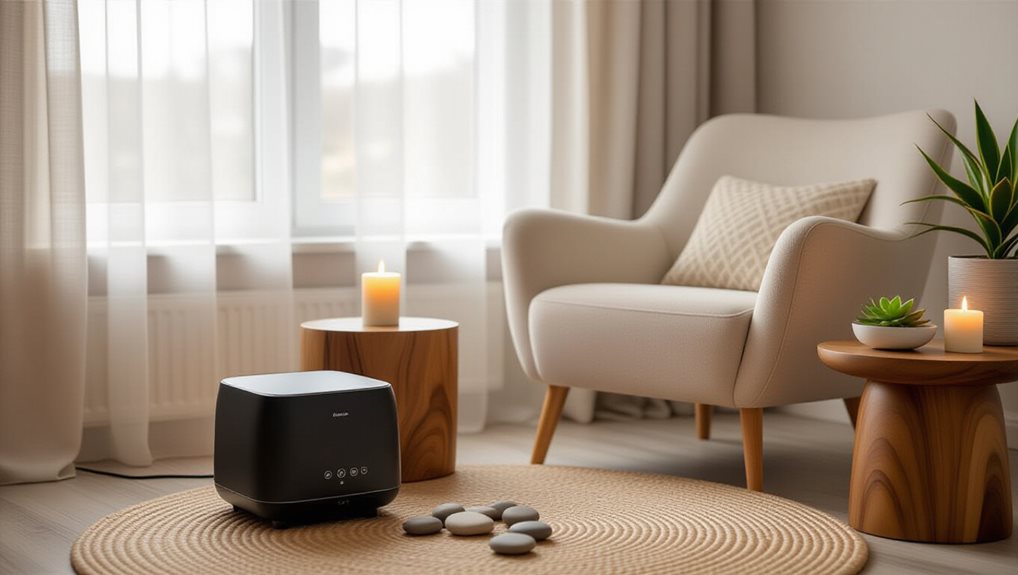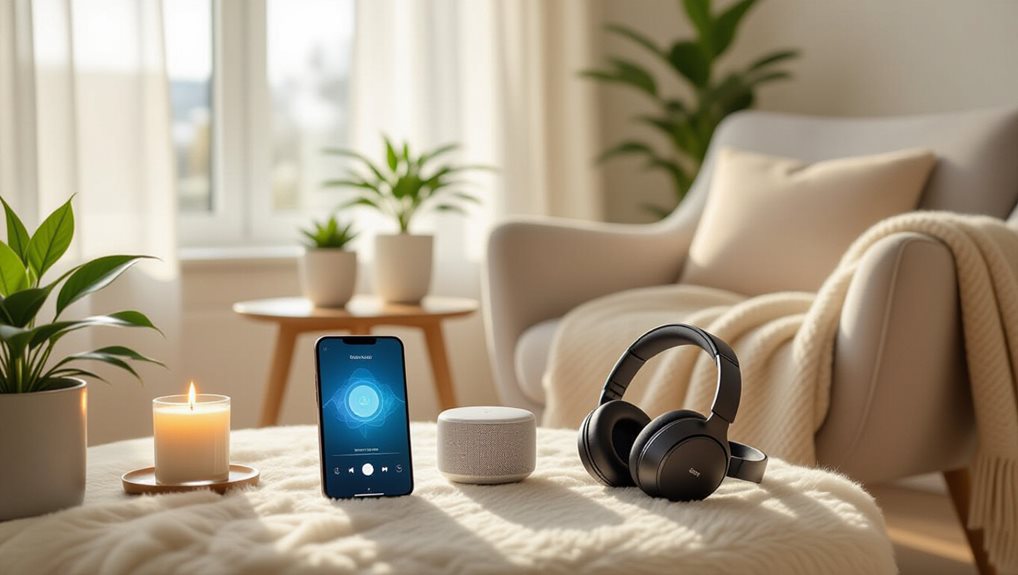To use sound therapy at home for anxiety relief, create a calm space with soft lighting and comfortable seating. Choose soothing sounds like nature recordings or instrumental music, and consider using binaural beats to improve relaxation. Establish a consistent routine—preferably at a set time daily—and use high-quality headphones or speakers. Deepen your experience with mindfulness techniques, and track your progress to adjust practices when necessary. Uncover more strategies to personalize your calming routine while you investigate sound therapy further.
Understanding Sound Therapy and Its Benefits

🎧 Try a Free Subliminal
No signup or login required — experience our Millionaire Mind Subliminal instantly.
Sound therapy involves using specific sounds or music to promote relaxation and reduce anxiety, and growing research supports its effectiveness. Clinical studies have shown that brainwave synchronization through sound can significantly influence mental states and emotional well-being.
Understanding its past overview reveals that humans have long recognized the healing power of sound, dating back thousands of years.
Modern research investigates sound frequencies, which can influence brain activity and emotional states. Certain frequencies, like alpha and delta waves, are known to induce calmness and sleep.
By engaging with these sound frequencies, you can create a calming environment at home. The benefits include lowered stress levels, improved focus, and a sense of well-being.
Sound therapy is a non-invasive, accessible approach backed by evidence, making it a valuable tool for managing anxiety naturally and effectively.
Additionally, incorporating mindfulness techniques through sound therapy can further facilitate relaxation and reduce stress.
Choosing the Right Sounds for Anxiety Relief
When selecting sounds for anxiety relief, it’s crucial to choose those that resonate with your personal preferences and promote a sense of calm. Nature sounds, like flowing water or gentle rain, often evoke relaxation by mimicking natural environments. Instrumental music, such as soft piano or ambient melodies, can also help reduce stress without distractions. To find what works best, consider these options:
| Sound Type | Benefits | Ideal Use |
|---|---|---|
| Nature Sounds | Promotes tranquility, grounding | During meditation or bedtime |
| Instrumental Music | Eases mental tension | During work or relaxation |
| Nature Sounds | Mask background noise | While sleeping |
| Instrumental Music | Improves focus and calm | During calming routines |
Experiment with these to uncover which sounds foster your sense of peace. Incorporating binaural beats can further enhance relaxation by synchronizing brain waves to promote a calmer mental state. This process of brainwave entrainment helps the mind enter a more relaxed and focused state, amplifying the effects of sound therapy.
Setting Up a Calm and Comfortable Space

Creating a peaceful environment boosts the benefits of your chosen sounds and fosters a deeper sense of calm. To achieve this, focus on lighting options that promote relaxation—soft, warm lighting or dimmable lamps help create a soothing atmosphere.
Comfortable seating is just as essential; opt for supportive chairs or cushions that allow you to sit upright comfortably for extended periods. Declutter your space to minimize distractions and improve tranquility. This helps activate the parasympathetic nervous system for increased ease and relaxation.
Consider adding calming elements like plants or gentle textures to deepen your sense of serenity. When your environment feels safe and inviting, it becomes easier to focus on sound therapy and fully experience its anxiety-reducing effects.
A thoughtfully prepared space sets the foundation for a successful and restorative practice. Additionally, minimizing digital distractions can help enhance the calming effects of your sound therapy session.
Incorporating Sound Therapy Into Your Daily Routine
Integrating sound therapy into your daily routine can greatly improve its effectiveness in managing anxiety. Consistent practice helps reinforce calming associations and creates a sense of stability.
Regular sound therapy practice enhances anxiety relief and fosters a reassuring sense of stability.
To get started, consider these steps:
- Choose a specific time each day, like morning or evening, to engage in sound therapy as part of your daily rituals. This regularity supports the brain’s natural circadian rhythm, enhancing overall relaxation.
- Select calming sounds that resonate with you—whether nature sounds, gentle music, or white noise—to support relaxation. Different brainwave frequencies, such as alpha and theta waves, can help reduce anxiety and prepare the body for restful sleep.
- Keep your sound selection consistent to build familiarity and improve the calming effect.
- Create a dedicated space where you can focus without interruptions, making it easier to incorporate sound therapy seamlessly into your routine.
- Using binaural beats can further enhance relaxation by gently guiding brainwaves toward a calmer state.
Using Guided Recordings and Apps

Have you considered using guided recordings and apps to improve your sound therapy practice? Guided meditations can provide structure and focus, making it easier to stay engaged and relax deeply.
Many anxiety apps feature specialized sound therapy sessions designed to target stress and promote calmness, often incorporating soothing sounds and voice instructions. These tools are accessible and convenient, allowing you to practice anytime and anywhere. Using headphones is recommended to experience the full effect of binaural beats and sound therapy.
🎧 Start Your Audio Journey
Relax, recharge, and reprogram your mind with our Free Millionaire Mind Subliminal. No signup needed.
Research shows that guided meditations can reduce anxiety symptoms and boost emotional regulation. When choosing an app, look for those with reputable reviews and evidence-based content.
Incorporating guided recordings into your routine can deepen your relaxation experience and support your comprehensive mental health. Keep in mind, consistency is key to maximizing the benefits of sound therapy. Using alpha and theta frequencies during sessions may further enhance relaxation and anxiety reduction.
Tips for Enhancing Your Sound Therapy Experience
To truly optimize the benefits of sound therapy for anxiety, it’s crucial to thoughtfully improve your listening environment and routine.
Creating a calm, quiet space free of distractions can elevate your focus on sound frequency and promote relaxation. Incorporate mindfulness techniques, such as deep breathing or body scans, to deepen your experience. Using stereo headphones is essential to experience the full effect of binaural beats and sound therapy.
Consider the following tips:
- Use high-quality speakers or headphones for clearer sound and better immersion.
- Choose sound frequencies proven to promote relaxation, like alpha or theta waves.
- Dedicate a specific time daily for your sound therapy session to build consistency.
- Minimize external noise and set a comfortable, cozy environment to foster mindfulness.
These adjustments assist in deepening your practice, making relaxation more accessible and effective. Additionally, using binaural beats can help synchronize your brain waves to enhance relaxation and reduce anxiety.
Monitoring Your Progress and Adjusting Your Practice

Tracking your progress is essential to guarantee that sound therapy effectively reduces your anxiety over time. Regularly monitoring your improvement helps identify what works best and when to adjust frequency or techniques. Keep a journal or use an app to record your responses after each session, noting changes in anxiety levels. Using brainwave synchronization techniques can further enhance the benefits of your practice. Use the table below to evaluate your progress and inform adjustments:
| Time Frame | Notable Changes | Adjustments Needed |
|---|---|---|
| Weekly | Reduced anxiety | Increase session duration |
| Biweekly | Improved focus | Try different sound types |
| Monthly | Greater relaxation | Modify frequency or timing |
Incorporating personalized relaxation tracks can enhance the effectiveness of your sound therapy sessions by catering to your unique needs.
Common Questions
Can Children Safely Use Sound Therapy for Anxiety?
Children can safely use sound therapy if you select calming sounds suited to their sensitivity levels, monitor their reactions, and consult a healthcare professional to guarantee proper sound selection and duration, promoting comfort and reducing anxiety effectively.
Are There Specific Sounds Recommended for Different Types of Anxiety?
If you’re exploring sound therapy, nature sounds soothe general anxiety, while binaural beats may target specific types like panic or social anxiety. Always choose evidence-based options, and consult a professional to guarantee safe, personalized relief.
How Long Should Each Sound Therapy Session Last?
For ideal results, your sound therapy session duration should be around 20-30 minutes, 1-2 times daily. Adjust based on your comfort and response, ensuring consistent practice to effectively reduce anxiety and promote relaxation.
Is Sound Therapy Effective Alongside Medication or Therapy?
Sound therapy benefits your anxiety management and can complement medication or therapy effectively. It’s generally safe, but consult your healthcare provider initially to guarantee proper medication interaction and tailored treatment, enhancing general mental health support.
Can Sound Therapy Cause Any Adverse Effects or Discomfort?
Sound therapy can cause discomfort if you’re sensitive to sound, especially in cases of sound sensitivity. Your individual experiences matter; start gently, listen carefully, and consult a professional if you notice adverse effects or increased anxiety symptoms.
Final Thoughts
By integrating sound therapy into your daily routine, you’re planting seeds of calm that can blossom into lasting relief. Recall, patience and consistency are your best allies on this expedition. While you tune into soothing sounds, you’re crafting a sanctuary within—like a gentle lighthouse guiding you through stormy seas. Trust in the process, and over time, you’ll uncover a more peaceful mind waiting on the other side of each mindful moment.




